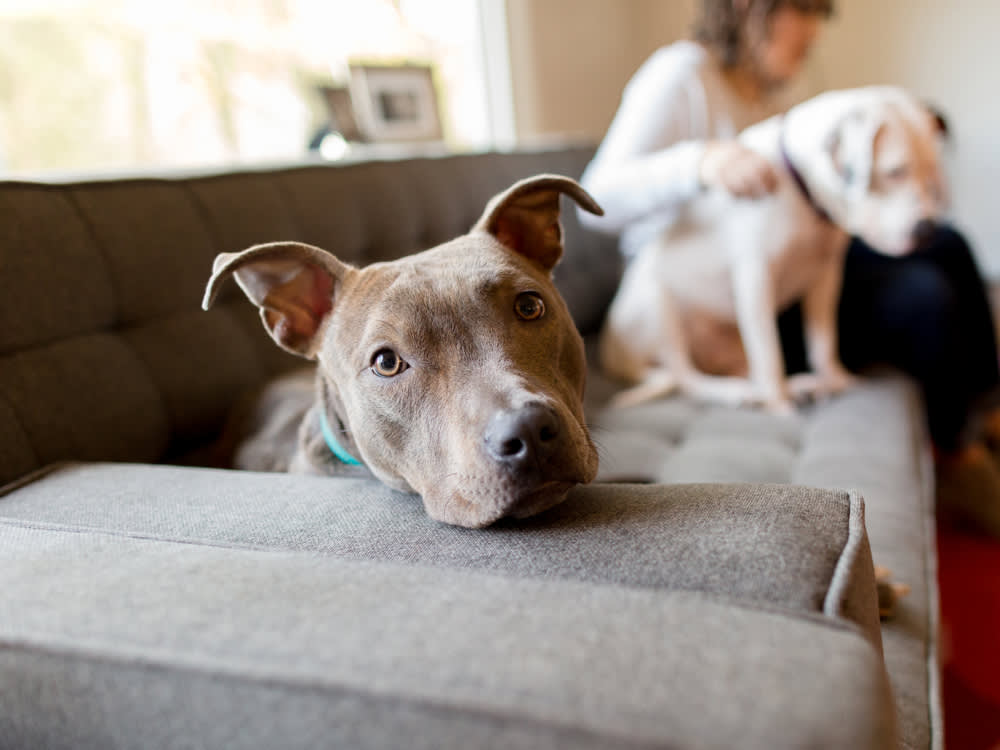How to Find a Pet-Friendly Rental
Searching for pet-friendly housing? Reading this should be your first move.
If you’re struggling to find an affordable, pet-friendly rental, you’re not alone. Seventy percent of Americans have at least one pet, according to the 2021-2022 American Pet Products Association survey. Combine this with an unstable rental market that’s driving up prices, a lack of safe rental housing in the U.S. to meet the demand, discriminatory breed bans by insurance companies and property owners alike. Add an eviction crisis that may put 10 million pets at risk of being separated from their families, and you can quickly see how housing tops the list of reasons pets are surrendered to shelters or rehomed to family and friends.
While we’re 100 percent pro-pet parents at Kinship, we can also understand why property owners may be hesitant to rent to someone with three pups or a herd of cats. The key in securing a pet-friendly rental is a combination of sheer luck and meeting property owners where they are. Here are some tips to help you get there.
Start Searching ASAP
It might sound like a no-brainer, but it’s important to note that you should give yourself plenty of time to search for a rental. If you have never moved with a pet, you’ll need to double the amount of time (and patience) you’ve needed in the past because your options are likely more limited — and your pet deserves the very best.
Remember How Wildly Popular Pets Are
Statistically speaking, it’s likely that most property owners have a pet of their own. They understand why you want to bring your pet along to your new place. Ask why they’re hesitant; did they have an irresponsible tenant in the past that caused damage? Have they had complaints from other tenants about allergies? Getting to the root of the “no” can help you craft a solution-oriented plan. Offer to leave a slightly higher deposit that would be returned to you if the rental is in good shape when you leave. Bring an air purifier and keep up with your pet’s grooming needs to reduce the dander that might make its way to a shared hallway.
How much do you spend on your pet per year?
Make A Pet Resume
Include your pet’s name, age, training accomplishments, your daily routine, how you’ll prevent destructive and nuisance behavior (are they crate or litter-box trained, how often are they exercised, how committed are you to picking up dog poop), and some things that make your pet unique and lovable. Include a health report that lists your pet’s vaccines and spay/neuter status. A Canine Good Citizenopens in new tab test can be an excellent way to show a landlord that your pup has obedience skills and can handle walking near people and other dogs.
Have References On Hand
Nothing — and we mean nothing — is more effective than when a previous landlord tells a future landlord what an awesome tenant you and your pet are. Ask them if you can give their number to future landlords or if they can write you a letter. Next, hit up your veterinarian and ask for a copy of your pet’s records and a recommendation that tells the story of how hard you work to keep your pet healthy. Lastly, ask friends, pet sitters, dog walkers, trainers, groomers, boarding facilities — anyone who knows your pet — to talk about their awesome qualities.
Get Renter’s Insurance
One of the biggest barriers to moving with a dog who is labeled as a Pit Bull-type dog (or Rottweiler, Doberman, or Shepherd) is a finger-pointing blame game between a property owner and their homeowner’s insurance. While there are insurance companies that don’t discriminate against breeds (such as State Farmopens in new tab) this is an easy out for a landlord who doesn’t want your pup in their rental. Renter’s insurance is a good idea regardless of the breed of dog you have; it adds additional protection should something happen.
DNA Test Your Dog
This can be an extension of renter’s insurance, but if your dog is a mix (and many rescues are), get a Wisdom Panel DNA testopens in new tab done and bring the results to potential landlords, particularly if they show little or none of the dog breeds that are traditionally discriminated against.
Prepare Talking Points
Landing a great rental can be a lot like politics, and it’s important to be prepared and practiced. Hit on the right points when you respond to rental ads: Be professional and proactive. List your pets and their attributes, and be sure to mention the references you’ve collected. Offer solutions instead of begging for exceptions.
Offer a Meet and Greet
Ask your landlord if they’d be comfortable with you bringing your dog along to a meeting. Suggest a pet-friendly space where you know your dog will be stress-free and focused. This can be a great way to show your landlord how well-behaved and unbelievably cute your dog is — and demonstrate how inseparable and familial the two of you are. Needless to say, it’s easier to be against the idea of a dog than a living, tail-wagging puppy standing in front of you.
Expand Your Search
If you’ve run out of options in the pet-friendly section of your search, start writing to landlords who have listed “no pets” in their ads. If you go this route, be polite, don’t pester if they don’t respond, and be ready to answer their concerns with solutions.
Looking for pet-friendly housing can be stressful, even more so if you need to stay in a certain area for your job or family, need to live near public transportation, or are on a limited budget. If all else fails, be thinking about friends and family, or even a foster parent through your local shelter, who might be able to provide temporary fostering while you continue your search. You can also visit My Pit Bull Is Familyopens in new tab, a landlord-founded organization with resources for pet parents seeking housing. Their housing databaseopens in new tab details dog-inclusive property listings within the U.S.









